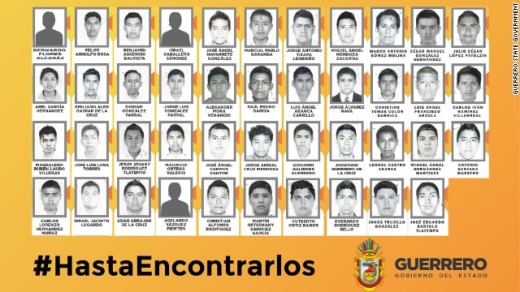
MEXICO CITY—The remains of one of 43 students missing since they were allegedly abducted in September has been identified by forensic experts, a Mexican government official said Saturday.
The official didn’t identify the student, but the official Facebook page of the teachers college attended by the missing students posted a message written as though from one of the missing, Alexander Mora Venancio, from beyond the grave.
“Argentine forensic experts confirmed to my father today that one of the bone fragments found belongs to me,” the Facebook message read.
The abduction—and presumed death—of the 43 students in September stunned Mexico, posing the most difficult challenge yet faced by President Enrique Peña Nieto since assuming power two years ago. The students were detained by municipal police in the city of Iguala, in the violence-riven southern state of Guerrero, and then allegedly handed over to a local drug gang for execution, Mexican officials say.
Since the abduction, tens of thousands of Mexicans have marched in protests across the country. While most marches have been peaceful, radical teachers and students have burned government buildings in Guerrero, where the students were abducted. Protesters have also frequently blocked the highway linking Mexico City to Acapulco, the once glamorous beach resort which is Guerrero’s largest city.
Since assuming power, Mr. Peña Nieto has pushed through ambitious economic reforms, including opening up Mexico’s oil industry to foreign investment.
But the public outcry over the disappearance and suspected killing of the students has forced Mr. Peña Nieto to again focus on the problem of Mexico’s widespread police and political corruption, the nation’s continuing insecurity and lack of rule of law.
In response, last week, Mr. Peña Nieto sent Congress proposals for police reforms that would lead to the merger of Mexico’s more than 1,800 municipal police forces into just 32 state forces.
The missing students were detained by police on Sept. 26, after police shot six people in a series of confrontations, Mexican officials say. The students, who attend a teachers college known for its radicalism, had come to Iguala, the third-largest city in Guerrero, to commandeer buses for use in a demonstration.
The students were detained by Iguala police on orders from Jose Luis Abarca, the mayor of the city, said Attorney General Jesus Murillo Karam in a news conference last month. Afterward, the police allegedly handed them over to a local drug trafficking gang who took the students to a nearby dump, killed them, burned their bodies, and threw the remains into a river, said Mr. Murillo Karam, citing the testimony of three of the alleged perpetrators, who have been detained.
Mexican authorities are holding more than 70 people in the case, including the mayor, his wife, alleged gang members and dozens of police from Iguala, and the nearby town of Cocula. None of them could be reached for comment.
The parents of the missing students, who say they deeply distrust the government, called on an independent Argentine forensic team to identify the few remains found by searchers. These have been sent to a laboratory at the University of Innsbruck in Austria for identification
At the news conference last month, Mr. Murillo Karam said the remains had been so incinerated that the few bone fragments left would make it impossible to identify all of the missing students.
Many parents have refused to believe the government’s story and continue to protest the students’ disappearance, insisting that they be returned alive.
The search for the missing Iguala students has turned up other horrors. Searchers dug up a number of other clandestine graves with more than 50 victims. DNA testing has shown that the bodies dug up from these graves are not the missing students.
The Mexican government estimates more than 22,000 people have disappeared in the last eight years of violence here that has seen cartels fighting each other and government security forces. During the same period, about 100,000 people are estimated to have died in drug-related violence.
Bron: Wallstreetjournal

